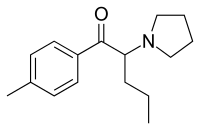Pyrovalerone
Pyrovalerone (Centroton, 4-Methyl-β-keto-prolintane, Thymergix, O-2371)[1] is a psychoactive drug with stimulant effects via acting as a norepinephrine-dopamine reuptake inhibitor (NDRI), and is used for the clinical treatment of chronic fatigue or lethargy[2] and as an anorectic or appetite suppressant for weight loss purposes. It was developed in the late 1960s and has since been used in France and several other European countries, and although pyrovalerone is still occasionally prescribed, it is used infrequently due to problems with abuse and dependence.[3] It is closely related on a structural level to a number of other stimulants, such as MDPV and prolintane (Promotil, Katovit).
 | |
 | |
| Clinical data | |
|---|---|
| Routes of administration | Oral |
| ATC code |
|
| Legal status | |
| Legal status |
|
| Identifiers | |
| |
| CAS Number |
|
| PubChem CID | |
| ChemSpider | |
| UNII | |
| ChEMBL | |
| CompTox Dashboard (EPA) | |
| ECHA InfoCard | 100.230.426 |
| Chemical and physical data | |
| Formula | C16H23NO |
| Molar mass | 245.366 g·mol−1 |
| 3D model (JSmol) | |
| Chirality | Racemic mixture |
| |
| |
| | |
Side effects of pyrovalerone include anorexia or loss of appetite, anxiety, fragmented sleep or insomnia, and trembling, shaking, or muscle tremors. Withdrawal following abuse upon discontinuation often results in depression.
The R-enantiomer of pyrovalerone is devoid of activity.[4]
See also
| Look up pyrovalerone in Wiktionary, the free dictionary. |
- α-Pyrrolidinohexiophenone (α-PHP)
- α-Pyrrolidinopentiothiophenone (α-PVT)
- Methylenedioxypyrovalerone (MDPV)
- Naphyrone (O-2482)
- Prolintane (Promotil, Katovit)
- 4'-Methyl-α-pyrrolidinohexiophenone (MPHP, 4-MPHP)
References
- US Patent 3314970
- Gardos G, Cole JO (October 1971). "Evaluation of pyrovalerone in chronically fatigued volunteers". Current Therapeutic Research, Clinical and Experimental. 13 (10): 631–5. PMID 4402508.
- Deniker P, Lôo H, Cuche H, Roux JM (November 1975). "[Abuse of pyrovalerone by drug addicts]". Annales Medico-Psychologiques. 2 (4): 745–8. PMID 9895.
- Meltzer PC, Butler D, Deschamps JR, Madras BK (February 2006). "1-(4-Methylphenyl)-2-pyrrolidin-1-yl-pentan-1-one (Pyrovalerone) analogues: a promising class of monoamine uptake inhibitors". Journal of Medicinal Chemistry. 49 (4): 1420–32. doi:10.1021/jm050797a. PMC 2602954. PMID 16480278.